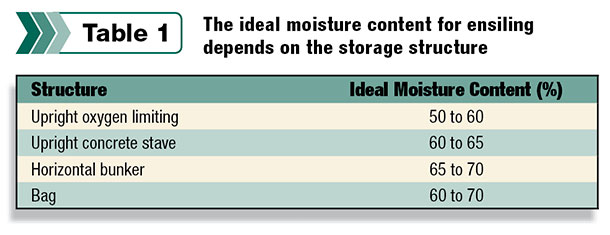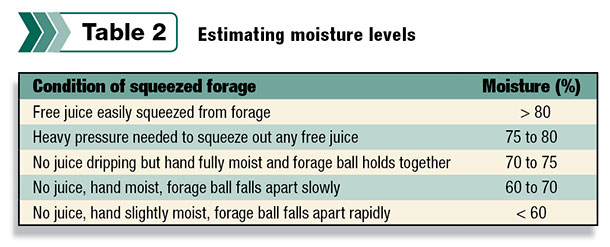Silage harvested too dry is difficult to pack sufficiently to force out the air. Trapped oxygen allows extended respiration by plant cells that will consume digestible nutrients. The silage often heats as yeasts and molds grow, which reduces silage yield and lowers energy and protein digestibility. Silage spoils quickly when re-exposed to air, shortening bunk life.

It isn’t easy to tell what the moisture content is just by looking at the field. The best method is to oven-dry a representative chopped sample at a commercial forage lab. This time-consuming process often is impractical, though, so methods that are reasonably accurate and in-field based are needed. Fortunately, there are several in-field methods that can determine forage moisture content reasonably closely. These include using a microwave oven, a heat-based dryer or the hand-squeeze test.
A microwave oven can provide quite accurate moisture estimates in just 10 to 20 minutes. Detailed procedures for using this method are available online from many sources and won’t be repeated here. Basically, a sample is collected, weighed wet and then dried for short intervals and reweighed repeatedly until no more weight changes occur. When done carefully to avoid charring or igniting samples from overheating, very useful estimates of forage moisture can be obtained.
Heat-based dryers look a little like a small, round deep-fat fryer or Crock-Pot. They use a fan to blow air heated by electric coils through a forage sample for rapid, accurate drying. Drying time varies with size and moisture content of the sample but generally is 30 to 45 minutes. Moisture content is determined by weighing the wet and dried samples.
Both of these drying methods require access to electricity and a scale for weighing. While they provide accurate and reasonably rapid moisture estimates, sometimes either the equipment or time are not available. That is when a crude but useful method of estimating moisture comes in handy.
The hand-squeeze test is simple and can be done anywhere by anyone. However, it is only a crude estimate of moisture content and takes a little experience to interpret the results successfully for specific applications. To use the hand-squeeze test, start by chopping some forage as you would to fill the silo. Then grab a couple handfuls of this chopped forage and squeeze them as tightly in your fists as you can for about 30 seconds.
Does free juice run or drip from your fingers? If so, the forage is too wet for best ensiling. What if it doesn’t drip? Then, slowly open your hand. Is your hand barely damp, and does the ball of foragestart to fall apart quickly? This forage may be too dry and is likely to heat and spoil in the silo. But, instead, are your fingers and palm moist, and does the ball you just squeezed tend to hold together or fall apart slowly? Then the moisture content is within the acceptable range for chopping silage.

These moisture estimates are not as accurate or precise as measurements from dried samples. Relying on them can be risky until sufficient experience has been obtained.
Bruce Anderson, Ph.D., is an agronomy and forage specialist for the University of Nebraska – Lincoln.










